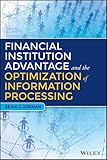Financial institution advantage and the optimization of information processing / Sean C. Keenan.
Material type: TextSeries: Wiley and SAS business seriesPublisher: Hoboken, New Jersey : Wiley, [2015]Description: 1 online resourceContent type:
TextSeries: Wiley and SAS business seriesPublisher: Hoboken, New Jersey : Wiley, [2015]Description: 1 online resourceContent type: - text
- computer
- online resource
- 9781119053224
- 1119053226
- 9781119053040
- 1119053048
- 9781119053309
- 1119053307
- 1119044170
- 9781119044178
- 9781322950211
- 1322950210
- Financial institution advantage & the optimization of information processing
- 332.10285 23
- HG173
Includes bibliographical references and index.
Print version record and CIP data provided by publisher.
This book offers a key resource for understanding and implementing effective data governance practices and data modeling within financial organizations. Keenan outlines the strategies and tools needed for financial institutions to take charge and make the much-needed decisions to ensure that their firm's information processing assets are effectively designed, deployed, and utilized to meet the strict regulatory guidelines. It includes practical observations about how information assets can be actively and effectively managed to create competitive advantage and improved financial results. It also includes a survey of case studies that highlight both the positive and less positive results that have stemmed from institutions either recognizing or failing to recognize the strategic importance of information processing capabilities. -- Edited summary from book.
Wiley & Sas Business Series; Title Page; Copyright; Dedication; Introduction; Acknowledgments; Chapter 1: Financial Institutions as Information Processors; Financial Institutions' Raison d'Être; Cultural Issues; IT Literacy and the Spreadsheet Deluge; Other Challenges to Establishing an IT-Savvy Culture; Notes; Chapter 2: Strategic Hardware and Software Management; Overview; An Integrated Data Architecture; Information Processing Efficiency as an Institutional Objective; A Digression on Unstructured Data; Notes; Chapter 3: Data, Models, and Information; Model Risk Mania
Definitions and EpistemologyData Quality; Models and Their Role; Regulatory Regimes and Guidance; Notes; Chapter 4: Model Risk Measurement; Three Phases of Model Management; Model Governance; Defining Model Risk; Objectifying the Downside; Model Risk Attribution: An Information Entropy Approach; Notes; Chapter 5: The Return on Analytic Assets; Measuring the Productivity of Models; Complementarity of Data Inflow with Information Processing; A Digression on Price Taking; Notes; Chapter 6: Data Risk Measurement; Strategic Data Acquisition; The Information Conversion Rate
Other Approaches for Data Risk AssessmentNotes; Chapter 7: A Higher Level of Integration; Alternate Views of Integration; Identifying Key Information Cycles; An Integrated Physical View; Multidimensional Information Asset Management; Chapter 8: A Strategy for Optimizing the Information Processing Complex; Evaluation; A Path toward Improvement; Notes; Chapter 9: Case Studies; The Pricing of Automobile Insurance; Moody's KMV; The London Whale; The Mortgage-Backed Securities Disaster; The Value of Annuities; Notes; Chapter 10: Conclusions; References; About the Author; index
Finance
